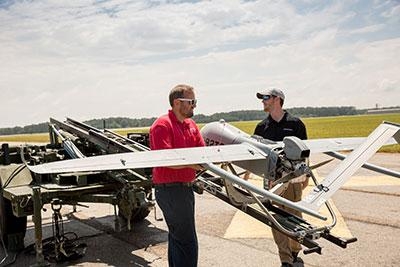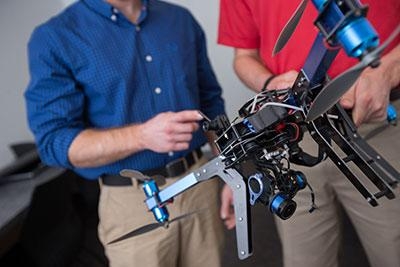Students Can Now Fly Unmanned Aircraft On Campus
With the FAA's first regulations regarding commercial use of Unmanned Aircraft Systems (UAS, commonly referred to as drones) released in June, training programs across the country are getting a boost.

Students at Liberty University School of Aeronautics’ UAS program have had opportunities to fly UAS in restricted areas, through industry partnerships. Now, the new regulations will allow them to fly small UAS (under 55 pounds) on campus for the first time. They will use fixed-wing and multi-rotor small UAVs (unmanned aerial vehicles), flying within the regulations which allow UAVs to operate within the operator’s line of sight, within 400 feet of the ground, and not over the heads of individuals who are not shielded by a structure. Students will have opportunities to gain experience outside of the classroom in providing services to the university, including aerial photography (including of Flames athletics events), search and rescue (if needed to support Liberty University Police Department), and data collection (including air testing and weather).
“We can provide quality operators to any company that wants to fly small UAS, so by being able to train the students on them, we are preparing them,” said Jonathan Washburn, director of Liberty’s UAS program. “They can go off into the industry after they graduate and now they have more options.”
While the regulations affect training programs for the smaller aircraft, Liberty’s UAS program continues to stand out in the crowd, becoming the only one in the country to offer students training leading to a full operator certification on a medium-sized UAS aircraft.
Through a partnership with Textron Systems, a company which operates the Aerosonde Small Unmanned Aircraft System (SUAS) (an aircraft with a 12-foot wingspan that has been used by a number of agencies, including the U.S. Department of Defense and NASA), Liberty students can now earn the same operator certification that Textron Systems requires of its employees. Students gain experience flying the Aerosonde SUAS at Textron Systems’ facility in Blackstone, Va. — a rare opportunity in the U.S. due to airspace restrictions. Because of the Textron Systems partnership, many Liberty UAS students are able to apply for a job before they even graduate from the program.

"By connecting with industry, we maintain the leading edge because Textron Systems will train our students on their current vehicles, as they come up with new software and hardware, they implement that in training,” Washburn said.
AUVSI projects that the UAS industry will create over 100,000 jobs are projected to be created over the next 10 years. Adam G. Leachman, Aerosonde project manager, said the relationship between Textron Systems and Liberty has led to job placements for many Liberty students. “We are very proud of our continued relationship with Liberty University,” he said. “The class and courses provided by Textron Systems are part of Liberty University’s School of Aeronautics curriculum — providing students with the ability to take a course that is unmatched in the marketplace.”
Leachman said the company is looking to include full maintenance/crew chief certification on the Aerosonde system for Liberty University in the future.
The first batch of students to take the full operator certification course, eight in all, completed their Aerosonde SUAS training in June at the Textron Systems Unmanned Systems Service & Support Center, which is about 80 miles from campus in Blackstone, Va.
The industry should only continue to grow as the FAA continues to update and expand regulations, which Washburn said will eventually allow for commercial use of medium and large UAS. “The major industry leaders are investing huge amounts of dollars into research and development to continue to develop their existing platforms and to build new platforms with new capabilities their hope is to expand their abilities and to increase their utilization of unmanned systems,” Washburn said. “We are anticipating rapid growth in the small UAS industry and continued growth in the medium/large UAS industry in America because there is usefulness to these vehicles, and all we are waiting on is the (legal) ability to fly them.”
(Images provided with Liberty University news release)
 ANN's Daily Aero-Linx (04.13.24)
ANN's Daily Aero-Linx (04.13.24) ANN's Daily Aero-Term (04.13.24): Beyond Visual Line Of Sight (BVLOS)
ANN's Daily Aero-Term (04.13.24): Beyond Visual Line Of Sight (BVLOS) Airborne 04.09.24: SnF24!, Piper-DeltaHawk!, Fisher Update, Junkers
Airborne 04.09.24: SnF24!, Piper-DeltaHawk!, Fisher Update, Junkers Aero-News: Quote of the Day (04.14.24)
Aero-News: Quote of the Day (04.14.24) ANN's Daily Aero-Term (04.14.24): Maximum Authorized Altitude
ANN's Daily Aero-Term (04.14.24): Maximum Authorized Altitude




